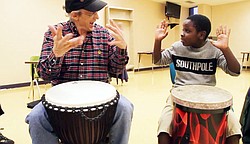For Dan and Pam Susany, the beat goes on and on
By LINDA M. LINONIS
YOUNGSTOWN
Dan Susany plants the seed rhythm for a drum circle, and the beat takes on a life of its own.
“Everyone plays along with what they feel,” he said. “There are no mistakes in drumming,” Pam Susany added.
The husband and wife drumming team leads drum circles for youth, elderly and others in the Valley. It began about 20 years ago when Pam retired from a career in mental-health counseling and social work. As a means of relaxation, she went to a drum circle with a friend, Patty Evans, and got caught up in the beat.
“It was a nice stress reliever,” Pam said. “It builds friendships.”
Pam invited her husband to a drum circle, and he, too, was drawn to the mesmerizing effect. “Medical evidence has shown that drumming is beneficial physically, mentally and emotionally,” Pam said.
“I just love to drum. It makes me happy,” Dan said.
Dan said the beauty of a drum circle is its simplicity. “Think about it ... the first music you hear in the womb is your mother’s heartbeat,” he said. “Rattles and drums are often the first toys children play with. Drumming brings out the rhythm within.”
On Tuesday and Thursday nights, the Susanys lead a drum circle for youth at Southside Fine Arts Academy based at Fairview Arts and Outreach Center, 4220 Youngstown-Poland Road. On Oct. 27, they participated as part of Southside’s program at Youngstown Afterschool Alliance’s “Lights on Afterschool Rally” at Choffin Career and Technical Center featuring some 25 interactive educational activities.
At Southside academy, there’s no need to drum up interest in the circle. The youth are naturally drawn to drums; and if they see one out, they’ll start drumming.
“Drummers in a circle don’t have to be in the same rhythm,” Dan said. “Rhythms do emerge.”
Pam said entrainment spontaneously happens. In biomusicology, it is defined as the synchronization of organisms to an external rhythm. “Participants fall into the same step,” she said.
For youth, Pam said drumming imparts various lessons. “It’s inclusive. Everyone is equal in the drum circle,” she said.
Pam said she also sees drumming as an anti-bully tool. She said the circle reinforces the idea of equality because no one sits at the “head.” “There’s a sense of belonging and accomplishment you get out of drumming,” Pam said. “It promotes teamwork and cooperation.”
She continued that drumming also helps develop coordination and listening skills.
The Susanys said children as young as 2 have participated in drum circles. Sessions last up to 45 minutes, and depend on participants’ attention span. “Having a good time is the goal,” Pam said.
The couple also presents drum circles at nursing homes, where participation is often surprising. In one incident, Pam said a nonverbal Alzheimer’s patient “would tap her feet” to the drumming. “I would ‘dance’ with her,” Pam said. One time, the patient told Pam she was tired. Her speaking was a shock, Pam said, adding she believed the drumming had prompted it. In other instances, near comatose patients have responded to the drumming by tapping their feet and/or hands and a former ballet dancer moved her feet in ballet positions as the drums played.
Pam said a child with debilitating physical disorder could feel the vibration of the drums. “He responded in a positive way,” she said.
“It’s very rewarding,” Dan said of such reactions. “People respond and remember.”
“Drumming reaches people,” his wife added.
Dan said they use a West African drum, djembe, which is the most common. It is West African in origin and has a goat skin top stretched over a wooden, goblet-shaped body. The Susanys said they also use heavy-duty plastic drums. “They can take a lot of beating ... literally,” Dan said.
The plastic drums don’t produce the mellow sound of the djembe but they serve the purpose when many kids are using them. But, he noted, shakers, rattles, bells, one’s body or a tabletop can be a “drum.”
Dan said people will recognize different drum rhythms. Native American drumming is slower-paced and has less tonal range while Nigerian drumming is faster. He noted in Nigeria, drumming, singing and dancing all go together. “Our culture is not oral like West African culture,” he said. “They have a strong rhythm culture.”
The Susanys’ calling card is May the Pulse Be with You. Contact them by email at drumdanpam@yahoo.com or call 330-536-3639.
 43
43

